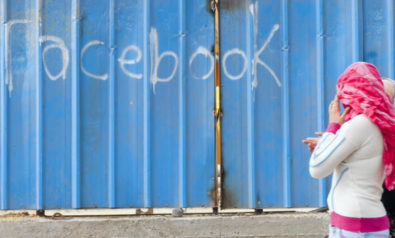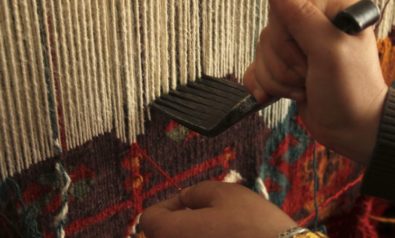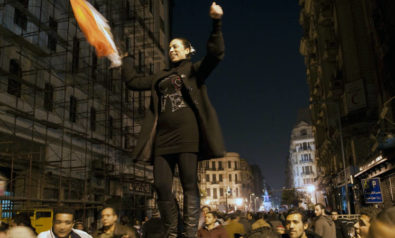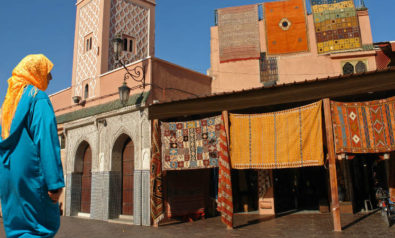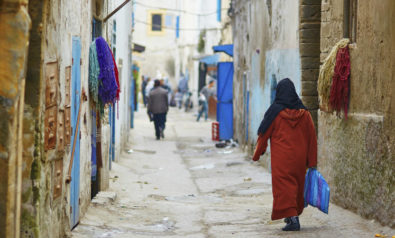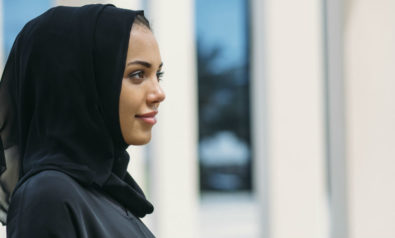Western media perpetuates a stereotype of veiled women largely based on sexist views, not on facts.
One of the striking images of the 2016 Rio Olympics was that of a beach volleyball game, with bikini-clad German player Kira Walkenhorst on one side of the net and Egyptian player Doaa Elghobashy on the other side, wearing a full body suit and a hijab (headscarf).
While many celebrated this image, which went viral across global and social media, as a marker of Rio’s diversity and a sign that sports are for everyone, other media outlets claimed that the image of veiled women was plain proof of these women’s oppression and imprisonment within the confines of a backward culture.
Fox News reporter and opinion writer Adam Shaw went as far as to say that the “ridiculous garb they [veiled athletes] are forced to wear in order to be able to compete is not a representation of freedom, but the symbol of the chains with which such countries and backward beliefs still shackle women.”
Oppression, Helplessness, Voicelessness
This view of veiled women as backward and oppressed is nothing new. Since the age of colonization, the Western world’s dominant image of women from the Middle East and North Africa (MENA) region has been one of oppression, helplessness and voicelessness. Over the years, this dominant stereotype has not significantly changed. In fact, world events, such as September 11, 2001, have only made this stereotype even more ingrained and widespread in the West.
Not only do Western media largely depict MENA women as oppressed and helpless, but the media often lump the diverse women of the region into one monolithic group, commonly represented by dark, all-encompassing veils. In doing so, the media completely ignore the diverse accomplishments and challenges of the millions of women who inhabit the 20 or so countries that make up the MENA region.
There is no doubt that women of the Middle East, like women across the globe, experience social, economic and political challenges that vary from one country to another. Yet it is also impossible to deny that these women are agents of change and are involved in the various developments that the region is witnessing.
Agents of Change
When the wave of Arab Uprisings swept the region in 2011, female activists from Morocco, Egypt, Libya, Yemen and elsewhere were at the forefront of these protests. In 2011, Tawakkol Karman, dubbed “the Mother of the Revolution” in Yemen, became the youngest person to be awarded a Nobel Peace Prize for her significant role in the Yemeni uprisings.
Sadly, these uprisings did not lead to the democracy and equality that MENA men and women were hoping for. But one could argue that a significant accomplishment of the region’s uprisings was how they empowered many people, including women. Today, women across the MENA region continue to make their voices heard and to demand social, political and economic rights.
In Egypt, female activists utilize everything from social media to street protests to graffiti art to raise awareness on the sexual harassment epidemic that impacts over 99% of Egyptian women. In fact, Egyptian women went from being shamed by their harassers to publicly shaming men who harass them and raising public awareness on this epidemic. More and more women today drag their harassers to a police station and openly discuss their harassment experience, a significant change from women’s years of silence and shame.
MENA women’s activism is sweeping many other countries besides Egypt. In Saudi Arabia, following the women’s 2011 #Women2Drive campaign that was spearheaded by activists such as Manal al-Sharif, Saudi women launched a new campaign in September 2016 to end male guardianship. Over 14,000 Saudi women signed a petition that was sent to the government, calling for an end to the monarchy’s male guardianship system that usually requires women to acquire a male relative’s consent to travel abroad, work or study. This recent movement extended to social media, with many others supporting the initiative under the hashtag #TogetherToEndMaleGuardianship.
Change can also be noticed with the women of Palestine. These women are among the region’s most challenged and also among its most empowered and resilient fighters. As journalist and activist Samar Al-Dreamly says, “Every day is a new Arab Spring for women in Palestine.” On a daily basis, Palestinian women resist Israeli occupation, humiliation at checkpoints, a nine-year Gaza Strip siege, while also managing small business in their communities, taking on leadership roles as well as working to gain political, social and economic equality with Palestinian men.
In war-torn Iraq, the case is no different. Nadia Murad Basee Taha became the first survivor of Islamic State (IS) atrocities to be awarded the title of ambassador for the dignity of survivors of human trafficking by the United Nations Office on Drugs and Crime (UNODC). Taha is now an activist for other Yazidi people in Iraq.
Waves of Change
When MENA women are not engaged in activism to achieve political or economic gains, they are making significant changes elsewhere. The Rio Olympics, for instance, brought to the forefront many MENA female athletes who made the region proud. These include Egypt’s weightlifter, Sara Ahmed, the first Egyptian woman to ever win an Olympic medal; Iran’s Kimia Alizadeh, who won a bronze medal in taekwondo, becoming the first Iranian woman to win an Olympic medal; and Tunisia’s Ines Boubakri, who became the first woman from MENA to win an Olympic medal in saber fencing.
Hence, while many in the West view MENA women as oppressed and backward, reality shows how these women have been and continue to be active and significant agents of change across the region.
Yet Western media ignore these women’s accomplishments and efforts. Instead, media outlets continue to frame veiled women with ethnocentric critiques, perpetuating a stereotype largely based on sexist views about women and not one based on facts.
MENA women’s achievements and struggles demonstrate that the veil donned by many of them does not thwart their activism. Rather, one could argue that the real hindering veil is the one that often clouds Western media’s judgment of these very same women.
The views expressed in this article are the author’s own and do not necessarily reflect Fair Observer’s editorial policy.
Photo Credit: djedzura
Support Fair Observer
We rely on your support for our independence, diversity and quality.
For more than 10 years, Fair Observer has been free, fair and independent. No billionaire owns us, no advertisers control us. We are a reader-supported nonprofit. Unlike many other publications, we keep our content free for readers regardless of where they live or whether they can afford to pay. We have no paywalls and no ads.
In the post-truth era of fake news, echo chambers and filter bubbles, we publish a plurality of perspectives from around the world. Anyone can publish with us, but everyone goes through a rigorous editorial process. So, you get fact-checked, well-reasoned content instead of noise.
We publish 2,500+ voices from 90+ countries. We also conduct education and training programs
on subjects ranging from digital media and journalism to writing and critical thinking. This
doesn’t come cheap. Servers, editors, trainers and web developers cost
money.
Please consider supporting us on a regular basis as a recurring donor or a
sustaining member.
Will you support FO’s journalism?
We rely on your support for our independence, diversity and quality.



